[RE-EDITED] Plans for Combat System Changes
By STAFF_Amy
May 10th, 2017
Greetings, TOS dev team here.
Our general goal for the year, besides system stabilization, has been creating and revising contents as a way to develop the gameplay of Tree of Savior into a more pleasant one for every player. The first big aspect we have in mind is PvP play, especially in terms of Team Battle League rules and general environment, and GvG stabilization. The second aspect we want to focus on are ways to connect the main storyline of TOS with future field, dungeon and raid updates.
The combat system changes we’re discussing today are deeply related to several aspects of the game we’re trying to improve with our plan, so we feel like they’re crucial when trying to produce noticeable results.
NOTE: These contents are still under development and can change before they are implemented.
1. Log Scale Down Formula
The current attack/defense-based damage formula of TOS, for example, doesn’t always engage with our initial idea of class/stat customization, physical/magic defense separation and high-rank attack in the most effective way. It also creates issues with not only PvP but also high-rank skills, items and monster balance. To improve on this, we decided to try a new ‘log scale down’ formula.
The log scale down formula is useful for calculating damage in an environment such as TOS where stats and items become stronger as the game is updated. The specific numbers will be different depending on the situation, but under this formula the new value for damage is calculated as follows.
damage = (% factor) x attack x log10 ((attack / defense + 1)^0.x + 1) + additional damage
: attack = current attack stated under Character Info and attack applied from buffs, items and attributes
: defense = current defense stated under Character Info and defense applied from buffs, items and attributes
: % factor = damage increase in a percentage value (+00%)
: + additional damage = damage increase in a numerical value (+00)
: log10 = log base 10
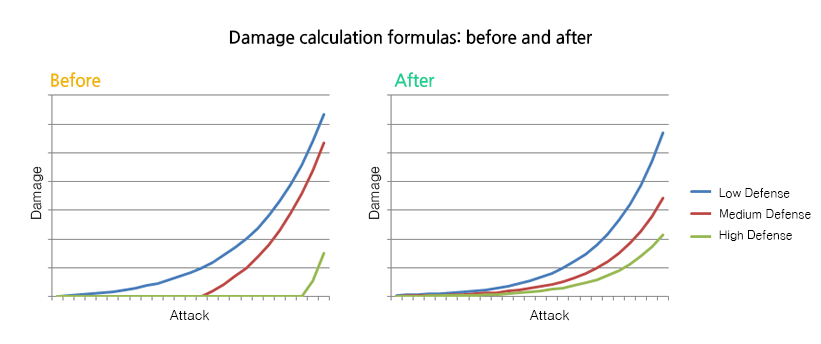
The subtraction formula used to calculate damage so far can produce some extreme results, especially considering that stats are customizable and attacks are divided into properties. This meant that, unless your character had some degree of defense, you could end up taking damage in the order of the thousands, but amp up your defense over a certain level and your character’s attack would drop dramatically.
Also, even if you did manage to balance your defense, facing an enemy with a higher attack than you would still take a very significant toll on your HP, further polarizing the extremes. This tied in with the problem of physical vs. magic defense, where if you invested solely on physical defense you would have no trouble dealing with a physical attack monster, but taking two or three hits from a magic attack monster in the same map would leave your character incapable of combat. Finally, there was the issue of balance differences between single- and multiple-hit skills.
In conclusion, this is what we expect to achieve with the new damage calculation formula:
- Provide a consistent damage system that takes into account the continuous increase of character and item stats.
- Increase the effectiveness of attack stats (STR, INT) and related items.
- Set a better foundation for future PvP (including GvG) and high-rank contents.
2. Skill Attack & Stat Calculation
In a system where it is possible to invest in low-rank classes even at higher ranks, our goal here was to support the efficacy of low-rank skills and preserve the value of attack stats (STR, INT) all the way to higher levels. To do this, we decided to change the current ‘simple addition’ calculation formula to a ‘skill factor’ formula.
2-1. Skill Attack Calculation
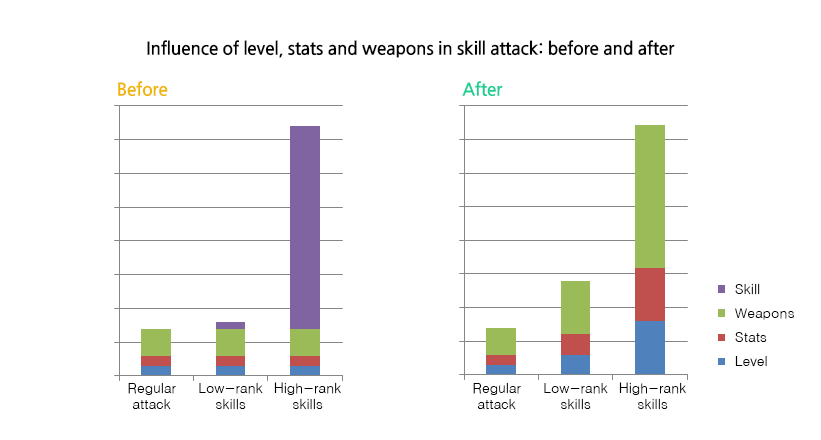
In the charts above you can see that, currently, in high-rank skills the attack depends largely on the skill’s attack itself, without much influence from level, stats or weapons. With the new calculation formula, the importance of level, stats and weapons is evenly distributed in skills of all levels.
We expect to change most attack skills to the new formula, making the performance of each skill take into account the skill’s range (no. of targets, width, AoE attack ratio) and casting time (moving/static), hit duration, channeling, SP/item consumption, cooldown time, overheat, added effects, etc. With this, we can expect to reduce the performance gap between high- and low-level skills, letting high-rank characters make better use of skills learned in lower ranks.
Buff skills that increase your attack/defense by a fixed number, like Blessing or Aspersion, will also change to a +% calculation. In doing so, single-hit skills, which got little effect from fixed-number buffs compared to multi-hit skills, can now get a better payoff from buff skills. However, we’re keeping fixed-number calculations for property skills where the attack value is influenced by item options and other sources, meaning the use of single- and multi-hit skills can change according to the enemy’s defense.
We also want to revise the performance, price etc. of buff, attack and “functional” skills to match the calculation changes discussed here. Any update details should be announced here in the dev blog or on future patch notes.
2-2. Stat Changes
First, we’re getting rid of “hidden” modifiers like the factors of physical defense, block and double-handed sword skills in the Swordsman tree; magic defense in the Wizard tree; and accuracy, evasion, critical chance and basic attack defense-reducing debuffs in the Archer tree. We’re also eliminating the bonus factor obtained from allocating points in the same stat to avoid promoting excessively disproportionate stat investment.
More specifically, here’s how we want to change each stat:
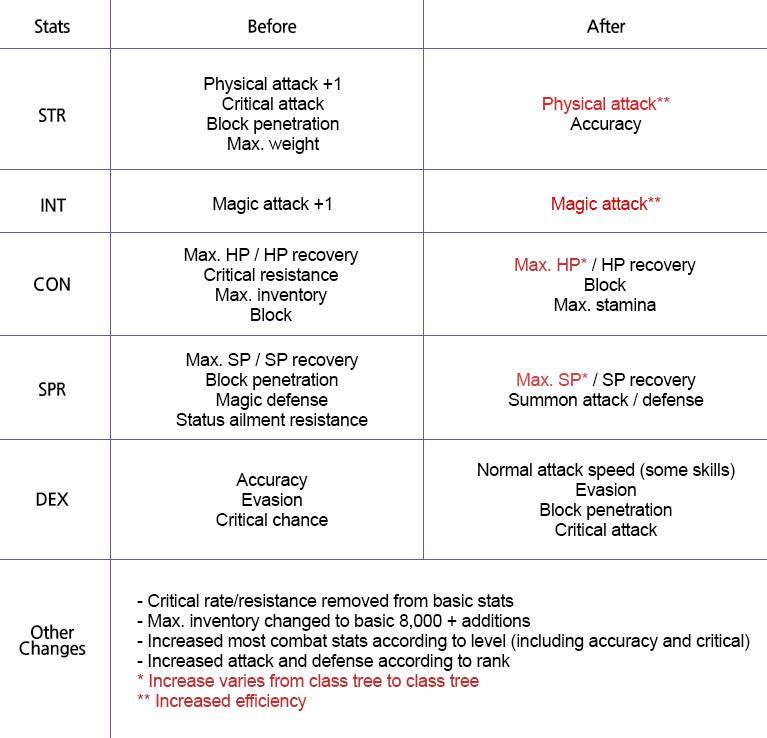
With broadened STR and INT attack increase ranges and new skill attack calculations, both STR and INT can maintain a steady influence on attack even in high-rank classes.
Accuracy and critical chance, which only apply to physical attack, get removed from DEX and are replaced by normal attack speed, making DEX a more general stat and preventing it from becoming useless to certain classes. INT, another stat which wasn’t always advantageous to invest in, gets boosted with higher efficiency in skills, and we’re also thinking of ways to have it influence status ailment resistance and summon stats.
2-3. Attribute Reset & Point Exchange
In an effort to address the burden of pricy high-rank attributes and prepare for future class updates, we want to allow players to reset their attributes and exchange them for attribute points. Under this system, the silver you invested in attributes can be converted according to a set rate into points, which you can then use to learn other attributes. The point exchange is done at the class master NPC, the same place where you learn your attributes.
We’re also planning to eliminate a few impractical and structurally ineffective attributes, and change the effects of the corresponding skills accordingly. Again, any updates will be announced here in the dev blog or on future patch notes.
2-4. Reset Event Plans
- To compensate players for the balance changes, we want to prepare an event where you can reset your stats, skills and class ranks at an event NPC. The NPC will provide one stat, skill and rank resetting item per day that can be used a single time and for one day only.
- We’ve solved the problem of the character’s EXP not carrying over after a rank reset, so the new item should let you reset your rank under class level 15 without going back to class level 1.
- During the event period, players will be exempt from advancement quests, so you’ll be able to advance ranks directly without a quest. This applies to all characters, including those who don’t use the reset item.
3. Item Stats & Enhancement/Transcendence System
Changing the skill calculation formula to a percentage-based one means we have to change item values as well. With the [(stat + item) x skill factor] attack formula as the foundation, equipment item attack/defense values will also be matched to the new balance changes. The scale of each value gets readjusted according to level and grade, growing to more than twice that of the current values, and particularly reducing the wide attack gap between one- and two-handed weapons. Besides this, we’re also introducing two new level 315 rapiers (rare, unique), but any changes regarding items will be announced via the patch notes when they’re ready to be implemented.
3-1. Equipment Production & Maintenance Costs
We’re planning a few changes to the production and maintenance costs of all equipment items. There will be differences in enhancement costs, required amount of gems for transcendence and repair fees according to the level and grade of the item. Additionally, we’re reducing production and maintenance costs for one-handed weapons and subweapons equipped by the same character.
3-2. Item Enhancement
While the chances of enhancement remain the same, the effects of enhancing an item are improved. After enhancement stage 6, when the chance of enhancement failure is introduced, there’s a slight increase in enhancement values with every fifth stage achieved (+11, +16, and so on). Besides this, the “safe enhancement” range of subweapons is increased from stage 3 to 5 and overall enhancement costs are reduced.
3-3. Main Armor Stats & Accessories
Currently, the main stat offered by upper/lower body armor is physical defense (magic defense being merely an added option), with gloves providing accuracy and boots evasion. This doesn’t always allow for a good stat distribution, so our plan is to apply physical and magic defense as main stats to all upper/lower body armor, gloves and boots, while removing the extra magic defense from plate armor and the additional physical defense from cloth armor.
Plate armor will offer higher physical defense, while cloth armor will provide better magic defense; meanwhile, leather armor will have lower physical and magic defense, but include other attack-focused features. These changes are also expected to affect existing attributes related to armor types.
This concept of duality is applied not only to armor, but to one-handed blunt weapons as well. The attack of these weapons may be lower than that of specialized physical attack one-handed swords or magic attack rods, but they’ll feature both physical and magic attack as main stats, allowing you to boost them via enhancement and transcendence similarly to armor items.
As for accessories, the Agny Necklace, an item with rather peculiar options, will now increase the factor of fire property skill attacks by 50%. Say, if Fireball has an attack factor of 230%, with an Agny Necklace equipped it will expand to 280%.
Along with this, we also want to readjust the attack factor of a few fire property skills to be more effective even without depending on the Agny Neckalce. We expect to follow the same approach with future attack type-specific accessories, although we don’t intend to base any balancing plans around specific items.
3-4. Transcendence
Following the new skill attack calculation changes, we expect item transcendence to have a higher influence on attack; here’s how we plan to readjust the system.
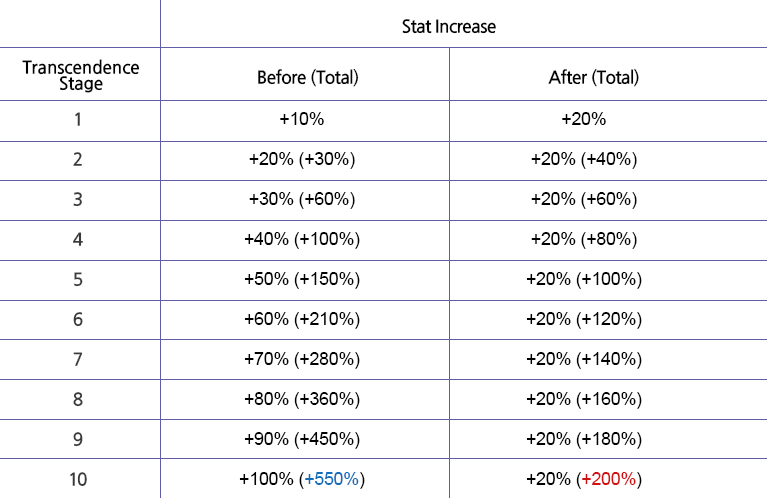
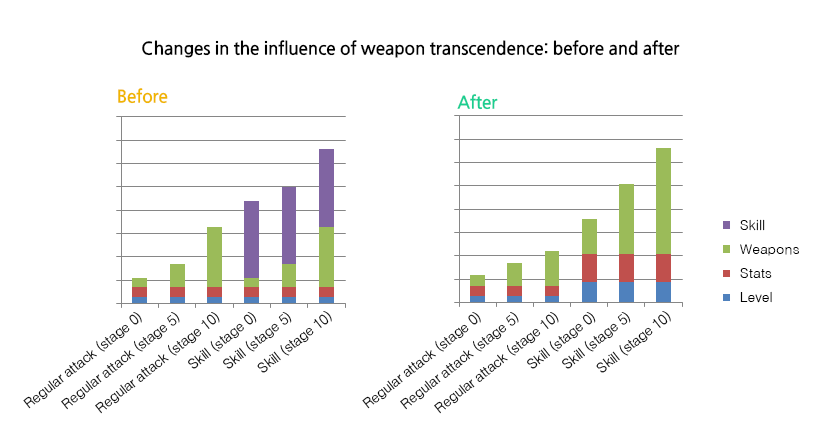
The increase in attack after transcendence stage 4 may have been reduced, but with the higher attack factor obtained from items and the new skill attack calculations, the influence of transcendence on overall attack remains a strong one. The main difference is simply the higher impact of character level and stats.
Another big change coming to the transcendence system will be the unification of the three varieties of Blessed Gems into a single item that can be used to transcend all types of equipment. To transcend a Lolopanther Two-handed Sword (level 270, unique, two-handed) to stage 10, for example, you won’t see much difference in the amount of Blessed Gems required; one-handed weapons and subweapons, however, will see a more visible reduction in the number of Blessed Gems needed for transcendence, as well as items of lower level and grade. On the other hand, items of level 270 and up (we’re talking ‘unique’ items here) will actually require more Blessed Gems to transcend. The price of Blessed Gem recipes is also expected to increase.
Furthermore, upon extracting Blessed Gems from an item, characters will get back 90% of the amount of gems used in transcendence attempts, instead of a percentage based on the item’s current stage of transcendence. The amount of Blessed Gems extracted will no longer reduce according to the remaining potential of the item.
Now, given the immeasurable amount of effort and funds already invested in the current transcendence system by so many players, we can’t simply apply the changes without compensation. Our plan is to, after resetting all transcended equipment, convert all the materials invested into the new unified Goddess’ Blessed Gems and distribute them back to the players. Any recipes and Blessed Gems you may have saved will also be exchanged for the new versions.
4. Field Balance Changes
We’ve done some tweaking to general field difficulty before with a mid-to-high-level monster stat reduction patch, so this time we want to match those changes to the revised combat formulas.
As a lot of you have already experienced, questing for EXP or farming items in Rank 8 fields (level 280 and up) as a solo player is not an easy task, making it almost mandatory for parties in those areas to be comprised of characters with specific builds and equipment. More often than not, this can turn regular solo players away from the fields, relegating them to instanced dungeons and missions. We figured that using the same field design on the high-rank regions currently being developed (levels 330 and up) would only aggravate the problem, so we decided to rebalance a series of field features as well.
So, to all existing fields, and those to be added in future updates, our plan is to apply the following principles.
4-1. Regular Field Difficulty
First, we want to readjust the difficulty of regular quest and subquest fields in a way that doesn’t make the contents too demanding to solo characters near the recommended level.
We’re improving on the excessive distribution of ‘special’ monsters with high HP by eliminating the distinction between ‘regular’ and ‘special’ monsters. The HP of monsters will instead be determined by the level, meaning current Rank 8 region monsters, for example, are getting a big reduction in their HP.
Also, monsters until level 100 will now provide more EXP, allowing early-level characters to quest their way to the higher levels without depending on instanced dungeons alone. Besides theses changes, our general goal is to improve the gameplay in general fields so that regular solo players can engage with all contents even without previous in-depth knowledge of the game’s systems.
4-2. Hunting Grounds & New Equipment
The monsters in Hunting Grounds are designed to be stronger than those in regular fields, with these hunting-focused regions serving mostly as a means to provide particular items. Characters with stronger equipment configurations can usually play solo at Hunting Grounds without much difficulty, while more common equipment setups may require parties of around 3 players.
Along with the updates discussed here, we’re planning to introduce 3 new Hunting Grounds for levels 280 to 330, providing a series of unidentified weapon and armor items with 270 and 315 minimum level requirements. The features in these new equipment items may be less flashy as those in other 270 and 315 rare/unique items, but they still offer decent attack and defense that are level-appropriate.
Finally, we’re adding normal 270 and 315 level items to an NPC shop in the Saalus Convent, in order to help balance out combat for high-level characters without identified items, and also prepare for post-level 330 content.
4-3. Monster Skills & Elite Monsters
With our planned update in effect, regular monsters that spawn in large numbers will no longer use “advanced skills” in combat. By “advanced skills”, we mean skills that affect your character’s movement (stun, knockdown, freeze, etc.) or those with a long duration that inflict poison, burn, slow and others. They will also stop running away for no apparent reason (we know that was a pet peeve for many…). Simple attack skills and buffs remain the same for these types of monsters.
Instead, we’re introducing new ‘elite’ monsters that accompany regular monsters and act as a sort of leader, with stronger combat features and more varied advanced skills.
The content revisions explained here are all part of our yearly plans to make TOS a friendlier game for players in the long run. The success of these plans will of course depend on whether players find them satisfactory or not, which is why we wanted to lay them out for you here.
These updates are going to be applied to our kTOS test server in April of 2017, and will likely arrive in iTOS in the early summer of 2017. We’ll make sure to announce any further details or modifications as they come up.
Thank you for sticking with us through this long post. Please let us know your thoughts or any questions you may have in the forum thread: [link]
We'll be gathering your feedback from the forums, so make sure to add your two cents! The answers should be published here at the dev blog a few days after we compile a good amount of questions.
